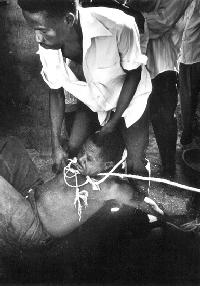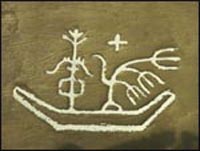
 |
|
|
|
|
Madonna to fund $5 million London occult centre Middle
aged pop star Madonna is to plunge $5 million into an occult centre based in London's West End, it has emerged. Middle
aged pop star Madonna is to plunge $5 million into an occult centre based in London's West End, it has emerged.According to today's Observer , quoting property paper the Estates Gazette, Madonna and her hubbie are behind the acquisition of property at 12 Stratford Place, W1 - which will cost £3.65 million in British money on behalf of the Kabbalah Society. The kabbalah is an originally Jewish system of theosophy which has numbered amongst its adherents Western occultists including Robery Fludd, Cornelius Henry Agrippa, poets like WB Yeats, and the self-styled Great Beast 666, Aleister Crowley. Jewish kabbalists claim that God taught the theosophical principles to angels in paradise, and after the fall it proceeded to Adam, Noah and then Abraham. The primary text of the book is Sefer ha Zohar. |
However, the Kabbalah Society, according to its web site, claims to descend from a somewhat separate Spanish tradition and describes itself as an "esoteric fusion of religion and
philosophy" dating back to medieval Spain where the three branches of the Abrahamic revelation met in a civilised cosmopolitan atmosphere, not unlike our own epoch.
In their version of the Kabbalah they have " brought together an esoteric fusion of religion and philosophy."
They relate its ancient theories and practices to contemporary psychology, science and art. site, claims to descend from a somewhat separate Spanish tradition and describes itself as an "esoteric fusion of religion and
philosophy" dating back to medieval Spain where the three branches of the Abrahamic revelation met in a civilised cosmopolitan atmosphere, not unlike our own epoch.
In their version of the Kabbalah they have " brought together an esoteric fusion of religion and philosophy."
They relate its ancient theories and practices to contemporary psychology, science and art.The hallmark of the Toledo line is Jacob's Ladder, a metaphysical scheme of four interlocking worlds that originate in the primordial Tree of Life mandala of Kabbalah. This diagram composed of Divine principles, paths and triads is the key to comprehending the plan of Existence and our part in it. The Society has groups on all five continents and periodically holds conferences and workshops in different countries. The Director of Tutors is Warren Kenton, whose books are written under his Hebrew name Z'ev ben Shimon Halevi. These thirteen volumes. which have been translated into almost as many languages, are the basis of the Toledano version of the Teaching. |
| Divining the Flaws of the Witchcraft Act Nebert Mulenga THE Witchcraft Act is just as controversial as the subject it is intended to address. And perhaps the most difficult crimes for the prosecution and judiciary to handle are those involving witchcraft. For in one vein the Act gives the impression that witchcraft does not go beyond one's belief yet in the other, it stipulates penalties for the practice of witchcraft. "A bunch of contradictory phrases and statements," would be a layman's verdict soon after running through the contents of Cap 90 of the Laws of Zambia. Under Section Four (4), the Act criminates even witch finders or diviners and herbalists as being guilty of practising witchcraft: be by habit or profession a witch doctor or witch finder shall be liable upon conviction to a fine of not more than one thousand five hundred penalty units or to imprisonment with or without hard labour for any term not exceeding two years, or to both." And yet, witch doctors continue operating openly in townships like Lusaka's Kanyama, Chawama, Matero, Kabanana and Lilanda as well as market places such as Soweto. Nowadays, they are even advertising their services in the Press, despite the law stating in black and white that even the making and selling of protective charms is an offense. Maybe it all goes to show that besides being archaic, the Act was designed by people with little understanding of the phenomenon. For the Act dates as far back as 1914, the year World War I started. As such, this pre-independence piece of legislation is made up of a number of Euro-Christian assumptions meant to suppress the belief in the existence of witchcraft and to protect witches from summary execution, bodily injury and damage to reputation. Local anthropologist Mulenga Kapwepwe blames it on the early missionaries who she says came to christianise, civilise, commercialise and colonise the African continent. To her, any of these four Cs sought to discard African beliefs and traditions as acts of paganism and a backward way of living. Ms Kapwepwe, who is in charge of the Cultural Sector Support Programme under the National Arts Council, feels the missionaries should have been more objective and considerate in dealing with witchcraft; for not all forms of witchcraft are evil. "Witchcraft helps to harness societies together and eases social and economic tensions. I believe in witchcraft and there's nothing sinister about it but the problem is that we have not explored it to the full capacity," she says. Witchcraft has existed for as long as man has lived on planet earth, a more precise reason why the Christian Bible forbids its practice in Exodus 22:18 and Deuteronomy 18:10. Catholic priest, Father Edwin Flinn who has done extensive research on the subject since 1953 when he first came to Zambia, says denying the existence of witchcraft is just as hypocritical as denying the existence of the devil. "Witchcraft grows with opposition and the two go hand in hand. I believe in the existence of evil, I also believe in God but as a missionary, I believe that God is always triumphant." For scholars of the Law however, what is of immediate concern is not the debate on the existence of witchcraft. Rather, it is the Act that regulates the subject of witchcraft and seeks "to provide for penalties for the practice of witchcraft and to provide for matters incidental to matters therewith." To them, it contains many serious judicial flaws which originate from the wrong premise of the Act; that witchcraft does not exist - an exact opposite of the view held by people who continue lynching, beating and even killing those suspected to practice witchcraft. |
 This year alone, more than 10 people have died at the hands of instant mob justices after being suspected of practising witchcraft, according to police spokesperson, Brenda
Muntemba. This year alone, more than 10 people have died at the hands of instant mob justices after being suspected of practising witchcraft, according to police spokesperson, Brenda
Muntemba.Demetria Hatoongo, a lawyer of Simeza Sangwa & Associates, says the framing of the Witchcraft Act makes it impossible for any lawyer to defend a case of witchcraft. "The Act tries to disbelief the existence of witchcraft and as a result, we only fight for a lesser term since all our judges have been trained under the Western Law," Ms Hatoongo says. So if the Act is flawed in content and relevance, making it difficult when proving a case, why has it not been amended? "The law is always sleeping as long as no one activates it. It is true that the Witchcraft Act is one of the most difficult pieces of legislation to deal with in our statutes but we have not received any complaint so far," says Dr Mwangala Kamuwanga of the Law Development Commission, an organisation mandated to research and recommend the amendment and repealing of archaic laws. That witchcraft is a supernatural phenomenon which cannot be fully comprehended by a natural mind or indeed the natural laws of science, is a view held strongly by Kamfwa Chishala. Mr Chishala, an attendant at the Lusaka National Museum, believes objects are invisible once in the hands of a wizard. The only person who can detect them at that stage is a witch finder. This is the core reason why prosecution of witchcraft cases is an exercise next to impossible, according to the Director of Public Prosecutions Mukelabai Mukelabai. It is a battle of legality and tradition. Mr Mukelabai says most offenses which manifest through the Witchcraft Act go unpunished because of the technicalities involved in proving a case. Evidential rules demand that "proof of a crime must be beyond any reasonable doubt." But would anyone prove a supernatural act using the natural laws of science? How would one prove that a witch spirited a foetus out of its mother's womb, or that a witch used lightning to strike someone dead? "A postmortem is the only authority we depend on in cases of unnatural deaths like those caused by suspected witchcraft. But a postmortem cannot bring out the fact that a person died of lightening," says Mr Mukelabai. "Prosecuting a case of witchcraft would entail using your beliefs as evidence but the law does not work that way." And Ms Muntemba contends that it is difficult for the police to arrest a person under the Witchcraft Act. Instead, the accused is usually given other charges like murder (if one professes to have bewitched and killed another), theft and in case of those who crash-land naked, indecent exposure. "Even where a person is found in your house naked under unexplainable circumstances, it will not be dealt with as a case of witchcraft but mere criminal trespass," adds the police spokesperson. Compared between rural and urban areas, Ms Muntemba says it would be easier to handle cases of witchcrafts in the rural set ups. But that notwithstanding, Senior Chief Mwata Kazembe of the Lunda people of Luapula Province maintains that the Act in its present form, favours witches more than the victims of witchcraft. "The Act presupposes that there is no witchcraft but what is prevailing on the ground is completely different. It is unfair to treat both the accused and the victim in the same way," the traditional ruler says, adding that when the time comes for amendments, traditional rulers should be allowed to participate in the reformation process of the Act. In the meantime, the controversy continues on the Witchcraft Act and the subject it is intended to address. |
|
Mysteries About Boat of Ancient Ba People In a book entitled Mysterious 30 Degrees North Latitude, the author has made a mystery of this special area by depicting a series of dangerous and supernatural phenomena such as the disappearance of planes and ships in Bermuda and the magical curses from Pharaoh in the Pyramids. These occurrences happened at 30 degrees north latitude, turning this area into a black hole in human knowledge. Thirty degrees north latitude crosses the Wuling Mountains of China, which span several provinces and autonomous regions and are the habitat to many people from the Tujia ethnic group. The area, with dense forest and roaring water, is believed to be the last home of the ancient Ba people. It is evident that the present Tujia people still share many customs from their Ba ancestors. Tao Yuanming, a famous poet of the Jin Dynasty (265-420), wrote an article entitled, “Peach Blossom Shangri-la” about a group of extraordinary people who lived in spectacular mountains and rivers. Tao would be surprised to know the area he once described still remains as mystical as if he lived there today. The people he represented had long since disappeared by the time he wrote about them. In 221 BC, General Sima Cuo of the Qin State led his army to conquer the Shu State in western Sichuan Province. He advanced his troops onward to Jianmenguan, attempting to take the Ba State in the middle reaches of the Yangtze River. Several months later, the Ba State came to an end under the converging attack of Qin and Chu. Many folk customs of the Tujia people in the Wuling mountainous area are rarely known by people. “Climbing the tree laddered with knife” is one of them. Even though performers of the act themselves can’t tell how the activity originated, they regard it as a form of entertainment today, and believe the ceremony’s significance is of interest to anthropology. On an unearthed artifact of significance from the Ba people, graphics have been found. Most of them hard to decipher. The item found is an ancient form of a bronze musical instrument. The boat is often found on these unearthed articles, with different boats possessing different meanings. For example, a graphic in the shape of the Chinese character “zhong” (meaning middle) in a boat’s stem may mean “sacrifice”, which might be a combination of sacrifices and sacred trees. While the symbol “+” is generally considered to represent the sun. The sacred tree was an intermediate between human and celestials or gods. Historical documents show that the ancient Ba people offered sacrifices to both gods and spirits. For them, sacrificial activities had the same importance as war. And they believed burning sacred articles would narrow the distance between themselves and heaven. |
 A sacred tree excavated from the Sanxingdui Ruins and belonging to an ancient Shu State contains similar graphics to that from the Ba people. Both show a thick tree trunk, and on top, a flower design. A bird stands on the tree and the branches are stooped. According to historical records, Ba and Shu cultures had completely blended by the time of the last Shu king. In this sense, can we believe the “sacred tree” was the origin of the “knife tree” activity of today? A sacred tree excavated from the Sanxingdui Ruins and belonging to an ancient Shu State contains similar graphics to that from the Ba people. Both show a thick tree trunk, and on top, a flower design. A bird stands on the tree and the branches are stooped. According to historical records, Ba and Shu cultures had completely blended by the time of the last Shu king. In this sense, can we believe the “sacred tree” was the origin of the “knife tree” activity of today?
Ancient Egyptians thought that, “the soul of the departed could avoid ghosts if it stepped onto the big sun boat, thereby finally reaching paradise.” However, ancient Ba people endowed greater meaning to the boat’s significance. |
|
|